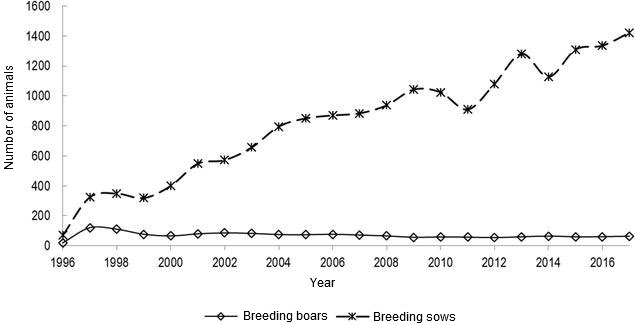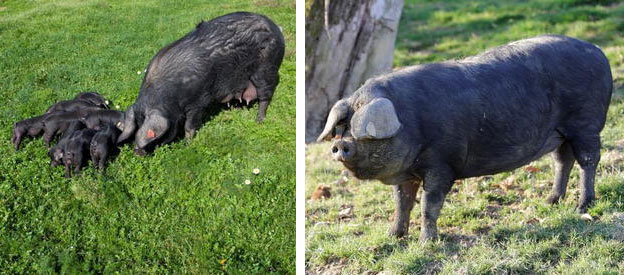History and the current status of the breed
The Gascon is a rare breed of domestic pig which has survived at the foot of the Pyrénées mountains in the southwest of France. This pig breed was already present in this region from ancient times: traces from the Gallo-Roman period were found. Like many other local breeds, its production declined during the second part of the twentieth century up to only 34 sows and 2 boars registered in 1981. However, a group of farmers, pork butchers and processors, with the help of technical advisors, gathered together with the objective of reviving the Gascon breed and its high-quality products. A breed conservation programme was developed with the help of IFIP and local agricultural chamber. Census of Gascon pig breed and its evolution over the last 20 years are presented in Figure 1. Presently there are 64 registered farms of Gascon pigs with 1423 breeding sows and 177 breeding males in the latest available status (year 2017).


Farms are either related to the Association des Eleveurs de Porcs Gascons des Hautes Pyrénées (AEPGHP), adhering to the Consortium du Noir de Bigorre (CNB), or the Association Nationale de Sauvegarde du Porc Gascon (ANSPG) or unrelated to any breeder group. AEPGHP represents 77% of the sows recorded in the LIGERAL herdbook.
In 2002, the CNB initiated process for further registration of their products as Protected Designation of Origin (PDO) quality label. With the Gascon breed, the CNB has progressively developed based on the production of local, high-quality pork products and vigorous efforts to communicate on their local pig production system as well as the high eating quality of their products. In 2015 the “Noir de Bigorre” fresh loin and “Noir de Bigorre” dry-cured hams, produced from Gascon pigs, obtained the French AOC (Appellation d’Origine Contrôlée) label, which is the national step towards registrations as PDO at European level. Both products obtained PDO registration in September 2017.
Exterior phenotypic characteristics
The Gascon pig breed morphology information is summarised in Table 1. The Gascon is a resistant, slow-growing breed able to live outdoors all year round. As described in the breed standard, animals have a cylindrical shape with thin and tough limbs. They have black skin and are black wire-haired with thicker hair along the dorsal stripe finishing in a swirl on the rump beside a cowlick on the top of the back. Gascon pigs face is characteristically pointed “like a mole” with narrow ears close to the base, slightly tilted over the eyes with length equal to half the length of the head (Figure 2).
Table 1. Summary of morphology information on Gascon pig breed.
| Measurement (average) | Adult male | Adult female |
|---|---|---|
| Body weight (kg) | 300 | 250 |
| Body length1 (cm) | 120 | 120 |
| Height at withers (cm) | 75 | 75 |
| Number of teats (average) | ≥12 | ≥12 |

Geographical location and production system
Gascon pigs produced in the local production system (Noir de Bigorre pork chain) are raised outdoor in extensive conditions at least during a 6-month finishing period. They consume large quantities of grass and fruits (acorns, chestnuts) depending on the season.
To benefit from AOC/PDO Noir de Bigorre registration, pure Gascon pigs must be born, reared and slaughtered in the specified geographical area. Pigs (either castrated males or females before any lactation) are generally born and kept indoors on straw with possible outdoor access, up to a maximum of 6 months of age. They are then placed until slaughter on natural or cultivated grassland (max. 20 pigs/ha) providing various grass species or leguminous plants, with possible access to a forest plot (e.g. acorns and chestnut). Plot lands must be approved by the authorities responsible for quality sign management and control. In addition to natural feeding resources, pigs are fed with complementary food based on a minimum of 70% cereals (wheat, oat, barley, rye and triticale) produced on the geographical area, with potential protein resources (faba beans, peas, rapeseed or sunflower meal), minerals and vitamins. Maize, sorghum and sunflower are not allowed. The farmers themselves often produce complementary food.
Pigs are slaughtered at a minimum of 12 and maximum of 24 months of age. Specifications for carcasses are a minimum of 100 kg of hot carcass weight, minimum 25 mm of fat depth over the gluteus medius muscle (ZP point) and 45 mm of muscle depth (ZP muscle). Whole traceability is guaranteed for pigs and carcasses. Minimum green ham weight of 10 kg and ripening duration of 20 months are required for AOC/PDO Noir de Bigorre hams.
Productive performance
Reproductive traits
For the last available 5-year period (2012–2016), the age of sows at first parturition is 17 months. On average, sows of Gascon pig breed have 1.7 litters per year with 8.1 piglets born alive. The death rate of piglets until weaning in the considered recent 5-year period is correct and averages 9.8%. Duration of the lactation is prolonged in comparison with modern intensive systems to 38 days, which is also reflected in the prolonged farrowing interval, 214 days on average. Thus, it can be concluded that Gascon pig breed has moderate fertility compared to the most prevalent breeds.

Growth performance
Due to big differences between studies with regard to the live weight range covered, we defined the stages for growth performance as lactation (regardless of how long it was), growing stage (from weaning to approximately 30 kg live body weight) and early, middle and late fattening stages estimated between approximately 30 and 60 kg, 60 and 100 kg and above 100 kg live body weight, respectively. The early, middle, late and overall fattening stage is characterised by slower growth than “modern” selected pigs and big heterogeneity for each of these growing stages as well as for the overall growing-finishing stage (342–537 g/day), related to the fact that this review comprises studies where different systems and feeding levels were considered. In the context of the evaluation of growth performance, it is also of interest to observe the extreme values, because it can be assumed that the maximum figures exhibit the growth potentials of Gascon pigs in ad libitum conditions of feeding (≈537 g/day in overall fattening stage).
Average estimated daily feed intake increased from 2.5 kg/day in the middle growing stage to max of 3.6 kg/day in the overall fattening stage, above values being probably overestimated and corresponding to daily feed distributed, whereas feed “intake” in overall fattening stage averaged 3.0 g/day.
Body composition and carcass traits
In considered studies, pigs of Gascon breed were slaughtered between 183 and 442 days of age and between 98 and 181 kg live weight and had a dressing yield around 80%. The backfat thickness measured at the level of the gluteus medius muscle (official site for fat depth measurement in the Noir de Bigorre AOC specification) was high (over 46 mm) but variable (38-49 mm). Backfat thickness was over 38 mm at the level of the last rib and 42 mm at the level of the first rib (neck). Muscle thickness measured at ZP point (minimum depth from the vertebral channel to the cranial end of the gluteus medius) was 69 mm on average. Muscularity assessed as lean meat content was between 35 and 40%. Overall, values of fat and muscle depths indicate lower muscular development and greater carcass fatness compared to modern breeds, which can be explained by the absence of selection against fatness and on carcass muscle content in the Gascon breed.
Meat and fat quality
pH measured in the longissimus muscle at 45 min and 24 hours post-mortem varied between 6.34 and 6.76 and 5.55 and 5.92, respectively. These are satisfactory values that indicate lack of major quality defects such as PSE or acid meat. The intramuscular fat content ranged between 2.0 and 3.3%. Fatty acid composition of backfat lipids shows high proportion of MUFA (47.6-54.2%) and SFA (39-46%) and low proportion of PUFA as compared to fatty acid profiles of backfat generally found in modern pig breeds. The high proportion of MUFA and low proportion of PUFA of backfat lipids from Gascon pigs can be explained by their high genetic potential for lipid deposition together with their high energy intake during finishing period, leading to high oleic acid production from lipogenesis, the PUFA resulting only from exogenous supplies in pigs.
Use of breed and main products
The French autochthonous pig breed Gascon is valorised in high-quality fresh pork and pork products, mainly by the CNB but also by independent producers. The local production system has now been recognised at French and European levels through recent obtaining of AOC and PDO official quality labels for Noir de Bigorre fresh pork and dry-cured hams. Mainly, the meat of Gascon pigs exhibits a dark red colour with low lightness, low rate and moderate amplitude of post-mortem pH decline, low drip loss and adequate IMF content, as well as white and firm backfat with high monounsaturated fatty and low polyunsaturated fatty acid proportions.
Dry-cured ham is the main and most “valued” product from Gascon pigs. Processors now intend to increase the hams’ ripening duration, from minimum of 20 months required in PDO specifications to 24 months.
Full text and references are available here: Gascon Pig.
Marie-José Mercat, Bénédicte Lebret, Herveline Lenoir and Nina Batorek-Lukač (February 6th 2019). Gascon Pig, European Local Pig Breeds - Diversity and Performance. A study of project TREASURE, Marjeta Candek-Potokar and Rosa M. Nieto Linan, IntechOpen, DOI: 10.5772/intechopen.83764. Available from: https://www.intechopen.com/books/european-local-pig-breeds-diversity-and-performance-a-study-of-project-treasure/gascon-pig



